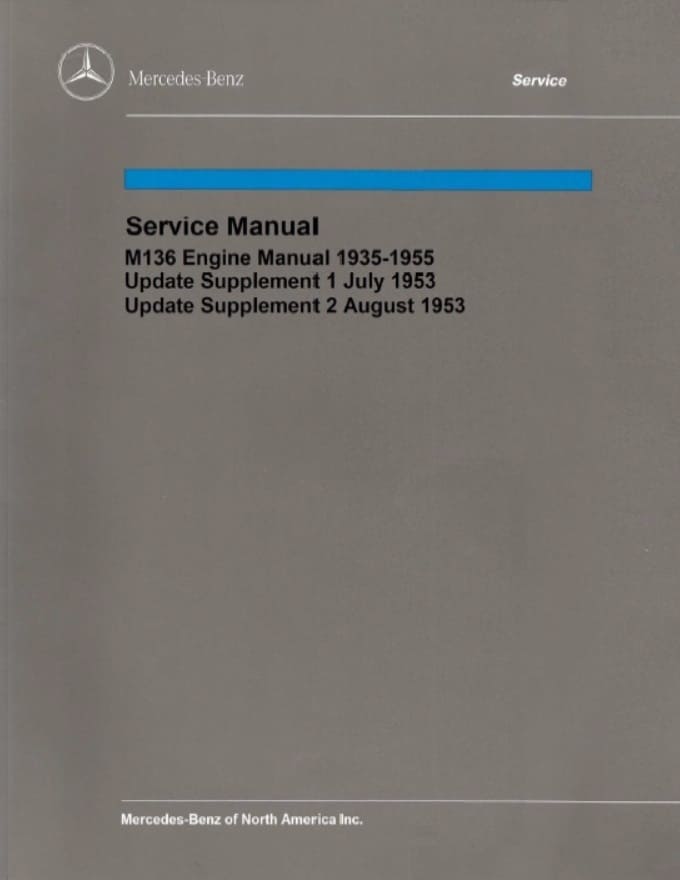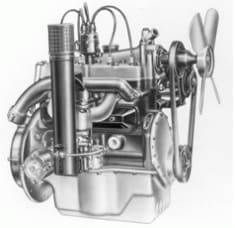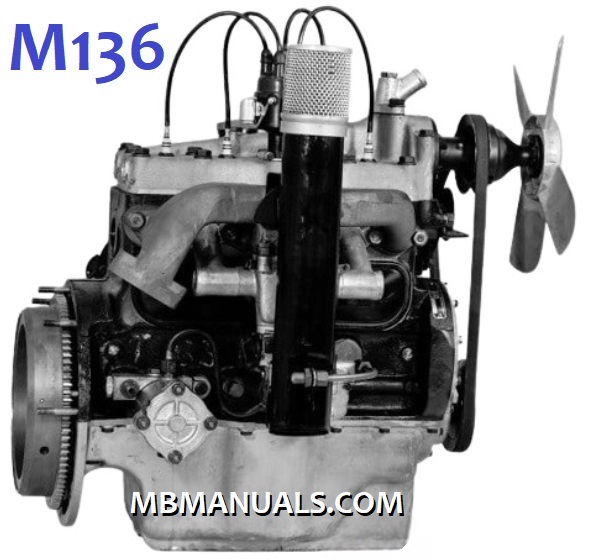Mercedes M136 Petrol Engine Manuals
The Mercedes-Benz M136 inline four-cylinder petrol engine was produced in two versions: 1.7 L (1,697 cc) pre-war engine bore, and 1.8 L (1,767 cc) post-war engine bore.
view all petrol gasoline & diesel engine manuals
Download: Mercedes Benz M136 Engine Service Manual
 Mercedes
M136 Engine Repair Manual
Mercedes
M136 Engine Repair Manual
Download: 13.3mb, 162 pages
Format: .pdf document
Application: W120, W136, W191
Download Link Sent to your PayPal email address
M136 Engine Technical Data
 The
Mercedes M136 engine family was composed of two versions with production
beginning before the outbreak of the Second World War, temporarily ended
during the war, and then resumed after the war.
The
Mercedes M136 engine family was composed of two versions with production
beginning before the outbreak of the Second World War, temporarily ended
during the war, and then resumed after the war.
The M136 1.7 L (1,697 cc) motor was introduced in 1935 for the W136 sedan, model 170 V. It was enlarged in 1950 to 1.8 L (1,767 cc) and installed in the W136 170Va 170Vb 170S, W120 180, and W191 170S, remaining in production until 1955 when it was replaced by the 1.9-litre M121.
The M 136 is a water-cooled motor (thermostat without short circuit) with valves arranged standing in a row on the right side. The triple bearing crankshaft and connecting rods are forged from steel. The camshaft is driven by a double roller chain. The engine initially had a riser carburetor (Solex 30 BFLVS), and later in the models 170 S / Sb (W 191) and 180 (W 120) a downdraft carburetor (Solex 32 PBJ).
Prior to the war in 1939, the M136 powered the 170V selling over 75 000 units by 1942. Production tooling survived world war II bombing and by 1947 it was again Mercedes top-seller until production ended in 1953. The V stands for ‘vorn’ (‘front’) to differentiate it from the previous W28 170H – ‘heck’ meaning (‘rear’) indicating engine location.
The initial capacity was 1697 cm³ (bore 73.5 mm, stroke 100 mm), and in 1950 it was increased to 1767 cc (75 mm bore, stroke 100 mm), increasing power from 38 to 45 hp.
M136 Versions
Common characteristics included: cast iron block, aluminum head, side valve-train, water cooled, Solex carburetor (two models)
M136 VI
-
 Version
VI 1.7 liter
Version
VI 1.7 liter - Production: 1935–1950
- Configuration: Inline 4
- Displacement: 1.7 L (1,697 cc)
- Compression ratio 6.5:1
- Cylinder bore: 73.5 mm (2.89 in)
- Piston stroke: 100 mm (3.94 in)
- HP: 38hp at 3600 rpm
M136.VII
- Version VII 1.8 liter
- Production: 1950–1955
- Displacement: 1.8 L (1,767 cc)
- Compression ratio: 6.5:1
- Cylinder bore: 75 mm (2.95 in)
- Piston stroke: 100 mm (3.94 in)
- HP: W136 170Va 170Vb - 45hp
- HP: W191 170 S / Sb - 52hp
- HP: W120 180 - 52hp
Applications
| W136 Chassis | Model | Engine | HP | Produced |
|---|---|---|---|---|
| 136 pre-war | 170V Sedan | 38 | 1936-1942 | |
| 170 VL Sedan | 38 | 1936 | ||
| 136 pre-war | L301 Van | 38 | 1937-1942 | |
| 170 VK Sedan | 38 | 1938-1942 | ||
| 170 VG Sedan | 38 | 1939-1943 | ||
| 136.010 | 170V | 136.920 | 38 | 1946-1950 |
| 136.010 | 170V | 136.921 | 38 | 1946-1953 |
| 136.060 | 170Va | 136.923 | 45 | 1950-1952 |
| 136.060 | 170Vb | 136.923 | 45 | 1952-1953 |
| 136.040 | 170S | 136.922 | 52 | 1949-1952 |
| 136.042 | 170S Cabriolet A | 136.922 | 52 | 1949-1951 |
| 136.043 | 170S Cabriolet B | 136.922 | 52 | 1949-1951 |
| 136.081 | 170S-V | 136.926 | 45 | 1953-1955 |
| W191 Chassis | Model | Engine | HP | Produced |
| 191.010 | 170Sb Sedan | 136.922 | 52 |
1952-1953 |
| W120 Chassis | Model | Engine | HP | Produced |
| 120.010 | 180 | 136.925 | 52 | 1953-1957 |


